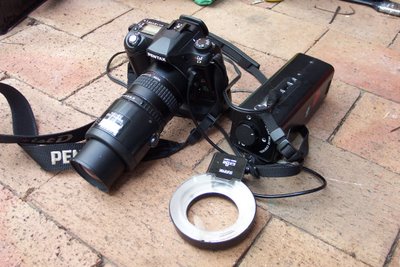 I've had a few requests to describe my photographic set-up, in particular the gear I used for Development in the duckweed.
I've had a few requests to describe my photographic set-up, in particular the gear I used for Development in the duckweed.My camera is a 6 megapixel digital SLR, the Pentax *ist D. It's a few years old now but still does a good job and has served me well. I think that in particular its big bright viewfinder is great for critical focusing, and the ability to use older lenses is a good thing for the student budget. I shoot only RAW these days, it really can't be beaten for the ability to change parameters like exposure, white balance, correct tints etc.
My two macro lenses are the brilliant Pentax FA 50mm f/2.8 macro and the cult classic Kiron 105mm f/2.8 macro. I use the latter for most of my flash work and with animals where the extra working distance is required. The 50mm comes in handy for high magnification stuff such as the frog egg photos where I used extension tubes for about 2:1 reproduction. Both of these lenses go down to 1:1 magnification but are frequently used for non-macro work too.
I try to use available light when possible but it becomes increasingly frustrating with camera shake at high magnification, subject movement, light loss... so I have the Pentax AF360FGZ flash which I use in off-camera conjunction with the onboard flash for things like frog photos. For higher magnification work I have an old battered manual ring flash with a PC sync connection which I just handold either around the lens or slightly to one side (used this for the egg photos). Generally the soft lighting it gives isn't ideal but it's the best thing I have for getting light onto subjects only centimetres from the lens.
(Edit: I've now started using my normal flash just handheld for the photos and prefer the results)
I don't use a tripod very often but for the egg photos I did set the camera up and just went and took a photo every now and then after positioning the flash. One frustration was reflection of the flash off the water's surface. I just had to play around with the angle of the camera and flash to avoid it.
My general bit of advice for photographers is to play around with things. Try different combinations, don't be afraid to use older lenses and extension tubes, bellows, reversing rings, close-up filters etc. Even compact cameras without interchangable lenses can deliver stunning and high quality results when paired with close-up filters or similar. Of course this sort of photography involves a lot of trial and error, but critically examine your 'dud' photos to decide what went wrong and try to improve things for next time. Practice on mundane subjects so you know what you're doing when something exciting comes along. And always try to get a photo of the interesting things you see, even if it's a relatively boring 'record' shot. Don't be reluctant to get the camera out of the bag, I know bitterly from experience how much you'll regret it later.
For the record, my other equipment:
Pentax A* 300mm f/4
Pentax K 55mm f/1.8
Pentax A 50mm f/2
Pentax A 28mm f/2
Pentax A 24mm f/2.8
Zenitar 16mm f/2.8 fisheye
Pentax manual bellows
CompactDrive Portable hard drive for storage
Manfrotto 190D tripod with 486 ball head
Manfrotto 679B monopod



1 comment:
Dave,
I recently bought a bellows for my Pentax Ist-D on EBay. The descriptions stated that it was for pentax digitals including Ist-d. I am having difficulty establishing any connections between the body and the bellows. I can mount it on the camera body, but all I get are dashed lines. I am unable to use the camera.
Any suggestions?
Thanks,
Barbara
Post a Comment